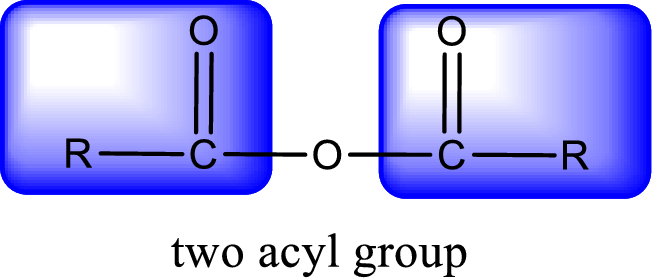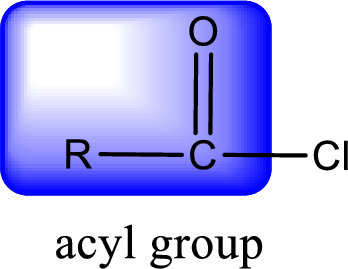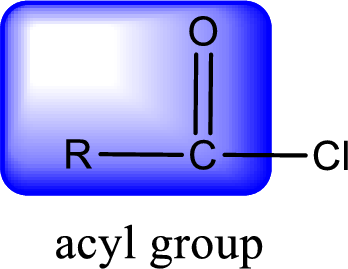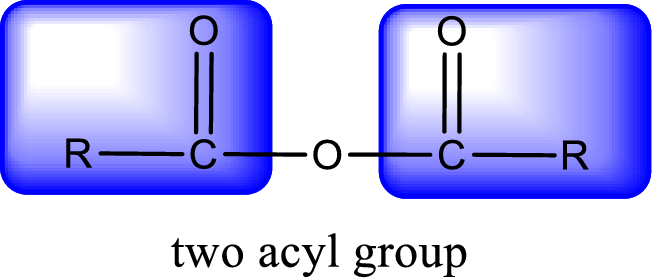
Concept explainers
(a)
Interpretation:
IUPAC name for the given compound has to be assigned.
Concept Introduction:
For naming an acid anhydride, it can be structurally viewed in a way that contains two carbonyl groups that is joined by a single oxygen atom. This can also be said as two acyl group joined by a single oxygen atom.

Rules to obtain IUPAC name and common name for an acid anhydride:
- IUPAC name and common name for Symmetric anhydride is obtained by replacing the acid present in the name of parent
carboxylic acid with the word anhydride. - IUPAC name and common name for mixed anhydride is obtained by using the names of the parent carboxylic acids arranged in alphabetical order that is followed by the word anhydride.
(b)
Interpretation:
IUPAC name for the given compound has to be assigned.
Concept Introduction:
For naming an acid chloride, it can be structurally viewed in a way that contains one acyl group with a chlorine atom bonded to the carbonyl group

Rules to obtain IUPAC name and common name for an acid chloride:
- IUPAC name for acid chloride can be obtained from the parent carboxylic acid name. In the parent carboxylic acid name, the ending “-oic acid” is replaced by “-oyl chloride”.
- Common name for acid chloride can be obtained from the parent carboxylic acid name. In the parent carboxylic acid name, the ending “-ic acid” is replaced by “-yl chloride”.
(c)
Interpretation:
IUPAC name for the given compound has to be assigned.
Concept Introduction:
For naming an acid chloride, it can be structurally viewed in a way that contains one acyl group with a chlorine atom bonded to the carbonyl group

Rules to obtain IUPAC name and common name for an acid chloride:
- IUPAC name for acid chloride can be obtained from the parent carboxylic acid name. In the parent carboxylic acid name, the ending “-oic acid” is replaced by “-oyl chloride”.
- Common name for acid chloride can be obtained from the parent carboxylic acid name. In the parent carboxylic acid name, the ending “-ic acid” is replaced by “-yl chloride”.
(d)
Interpretation:
IUPAC name for the given compound has to be assigned.
Concept Introduction:
For naming an acid anhydride, it can be structurally viewed in a way that contains two carbonyl groups that is joined by a single oxygen atom. This can also be said as two acyl group joined by a single oxygen atom.

Rules to obtain IUPAC name and common name for an acid anhydride:
- IUPAC name and common name for Symmetric anhydride is obtained by replacing the acid present in the name of parent carboxylic acid with the word anhydride.
- IUPAC name and common name for mixed anhydride is obtained by using the names of the parent carboxylic acids arranged in alphabetical order that is followed by the word anhydride.
Trending nowThis is a popular solution!

Chapter 16 Solutions
EBK GENERAL, ORGANIC, AND BIOLOGICAL CH
- Assign the functional group bands on the IR spectra.arrow_forwardFind the pH of a 0.120 M solution of HNO2. Find the pH ignoring activity effects (i.e., the normal way). Find the pH in a solution of 0.050 M NaCl, including activityarrow_forwardPlease help me answer these three questions. Required info should be in data table.arrow_forward
- Draw the major organic substitution product or products for (2R,3S)-2-bromo-3-methylpentane reacting with the given nucleophile. Clearly drawn the stereochemistry, including a wedged bond, a dashed bond and two in-plane bonds at each stereogenic center. Omit any byproducts. Bri CH3CH2O- (conc.) Draw the major organic product or products.arrow_forwardTartaric acid (C4H6O6) is a diprotic weak acid. A sample of 875 mg tartaric acid are dissolved in 100 mL water and titrated with 0.994 M NaOH. How many mL of NaOH are needed to reach the first equivalence point? How many mL of NaOH are needed to reach the second equivalence point?arrow_forwardIncluding activity, calculate the solubility of Pb(IO3)2 in a matrix of 0.020 M Mg(NO3)2.arrow_forward
- Order the following series of compounds from highest to lowest reactivity to electrophilic aromatic substitution, explaining your answer: 2-nitrophenol, p-Toluidine, N-(4-methylphenyl)acetamide, 4-methylbenzonitrile, 4-(trifluoromethyl)benzonitrile.arrow_forwardOrdene la siguiente serie de compuestos de mayor a menor reactividad a la sustitución aromática electrofílica, explicando su respuesta: ácido bencenosulfónico, fluorobenceno, etilbenceno, clorobenceno, terc-butilbenceno, acetofenona.arrow_forwardCan I please get all final concentrations please!arrow_forward
 Organic And Biological ChemistryChemistryISBN:9781305081079Author:STOKER, H. Stephen (howard Stephen)Publisher:Cengage Learning,
Organic And Biological ChemistryChemistryISBN:9781305081079Author:STOKER, H. Stephen (howard Stephen)Publisher:Cengage Learning, General, Organic, and Biological ChemistryChemistryISBN:9781285853918Author:H. Stephen StokerPublisher:Cengage Learning
General, Organic, and Biological ChemistryChemistryISBN:9781285853918Author:H. Stephen StokerPublisher:Cengage Learning


